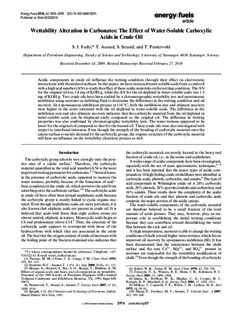| dc.contributor.author | Fathi, Seyed Jafar | |
| dc.contributor.author | Austad, Tor | |
| dc.contributor.author | Strand, Skule | |
| dc.contributor.author | Puntervold, Tina | |
| dc.date.accessioned | 2013-07-23T13:11:13Z | |
| dc.date.available | 2013-07-23T13:11:13Z | |
| dc.date.issued | 2010 | |
| dc.identifier.citation | Fathi, S J., Austad, T., Strand S., Puntervold, T. (2010) Wettability alteration in carbonates: the effect of water-soluble carboxylic acids in crude oil. Energy & Fuels 24(5), pp. 2974–2979 | no_NO |
| dc.identifier.uri | http://hdl.handle.net/11250/183216 | |
| dc.description | "Reprinted
(adapted) with permission from Fathi, S J., Austad, T., Strand S., Puntervold, T. (2010) Wettability alteration in carbonates: the effect of water-soluble carboxylic acids in crude oil. Energy & Fuels 24(5), pp. 2974–2979. Copyright
(2010) American Chemical Society.
The article forms part of Jafar Fathi's PhD thesis: Water-based enhanced oil recovery (EOR) in carbonate reservoirs : initial wetting condition and wettability alteration by "Smart Water", Stavanger : University of Stavanger | no_NO |
| dc.description.abstract | Acidic components in crude oil influence the wetting condition through their effect on electrostatic interactions with the mineral surfaces. In this paper, we have extracted water-soluble acids from a crude oil with a high acid number (AN) to study the effect of these acidic materials on the wetting condition. The AN for the original oil was 1.8 mg of KOH/g, while the AN for the oil depleted in water-soluble acids was 1.5 mg of KOH/g. Two crude oils have been studied by a chromatographic wettability test and spontaneous imbibition using seawater as imbibing fluid to determine the differences in the wetting condition and oil recovery. In a spontaneous imbibition process at 110 °C, both the imbibition rate and ultimate recovery were higher in the cores saturated with the oil depleted in water-soluble acids. The difference in the imbibition rate and also ultimate recovery indicates that the carboxylic material from the oil depleted in water-soluble acids can be displaced easily compared to the original oil. The difference in wetting properties was also confirmed by chromatographic wettability tests. The water wetness appeared to be lower for the original oil compared to that for the treated oil. These crude oils were also investigated with respect to interfacial intension. Even though the strength of the bonding of carboxylic material onto the calcite surface is mostly dictated by the carboxylic group, the organic structure of the carboxylic material will have an influence on the wettability alteration process as well. | no_NO |
| dc.language.iso | eng | no_NO |
| dc.publisher | American Chemical Society | no_NO |
| dc.subject | wettability | no_NO |
| dc.subject | carbonates | no_NO |
| dc.title | Wettability alteration in carbonates: the effect of water-soluble carboxylic acids in crude oil | no_NO |
| dc.type | Journal article | no_NO |
| dc.type | Peer reviewed | no_NO |
| dc.type | Doctoral thesis | |
| dc.subject.nsi | VDP::Technology: 500::Rock and petroleum disciplines: 510::Petroleum engineering: 512 | no_NO |
| dc.source.pagenumber | 2974–2979 | no_NO |
| dc.source.volume | 24 | no_NO |
| dc.source.journal | Energy & Fuels | no_NO |
| dc.source.issue | 5 | no_NO |
| dc.identifier.doi | 10.1021/ef901527h | |
